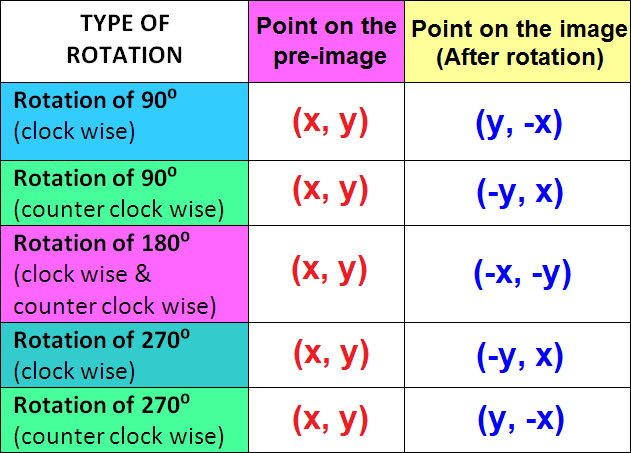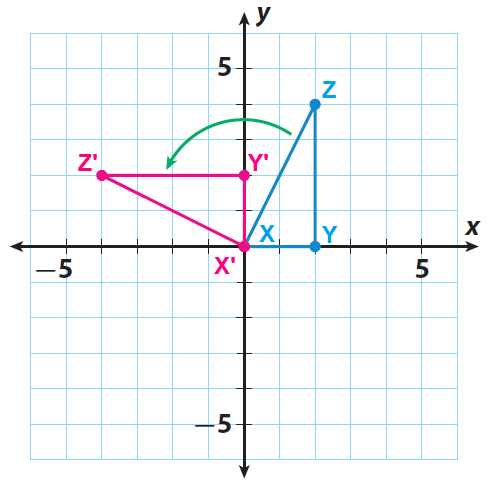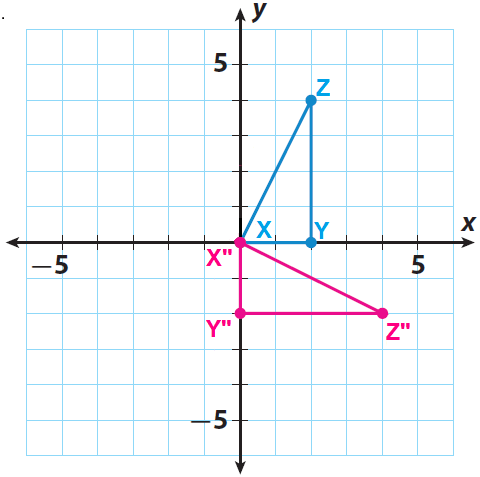ALGEBRAIC REPRESENTATIONS OF ROTATIONS
To rotate a figure in the coordinate plane, rotate each of its vertices. Then connect the vertices to form the image.
We can use the rules shown in the table for changing the signs of the coordinates after a reflection about the origin.

Example 1 :
The triangle XYZ has the following vertices X(0, 0), Y(2, 0) and Z(2, 4). Rotate the triangle XYZ 90° counterclockwise about the origin.
Solution :
Step 1 :
Trace triangle XYZ and the x- and y-axes onto a piece of paper.

Step 2 :
Let X', Y' and Z' be the vertices of the rotated figure.
Since the triangle is rotated 90° counterclockwise about the origin, the rule is
(x, y) ----> (-y, x)
Step 3 :
X(0, 0) ----> X'(0, 0)
Y(2, 0) ----> Y'(0, 2)
Z(2, 4) ----> Z'(-4, 2)
Step 4 :
Sketch the image X'Y'Z' using the points X'(0, 0), Y'(0, 2) and Z'(-4, 2).

Example 2 :
The triangle PQR has the following vertices P(0, 0), Q(-2, 3) and R(2,3). Rotate the triangle PQR 90° clockwise about the origin.
Solution :
Step 1 :
Trace triangle PQR and the x- and y-axes onto a piece of paper.

Step 2 :
Let P', Q' and R' be the vertices of the rotated figure.
Since the triangle is rotated 90° clockwise about the origin, the rule is
(x, y) ----> (y, -x)
Step 3 :
P(0, 0) ----> P'(0, 0)
Q(-2, 3) ----> Q'(3, 2)
R(2, 3) ----> R'(3, -2)
Step 4 :
Sketch the image P'Q'R' using the points P'(0, 0), Q'(3, 2) and Z'(3, -2).

Example 3 :
A quadrilateral has the following vertices A(0, 0), B(1, 2), C(4, 2) and D(3, 0). Rotate the quadrilateral 180° clockwise about the origin.
Solution :
Step 1 :
Trace the quadrilateral ABCD and the x- and y-axes onto a piece of paper.

Step 2 :
Let A', B', C' and D' be the vertices of the rotated figure.
Since the quadrilateral is rotated 180° clockwise about the origin, the rule is
(x, y) ----> (-x, -y)
Step 3 :
A(0, 0) ----> A'(0, 0)
B(1, 2) ----> B'(-1, -2)
C(4, 2) ----> C'(-4, -2)
D(3, 0) ----> D'(-3, 0)
Step 4 :
Sketch the image A'B'C'D' using the points A'(0, 0), B'(-1, -2), C(-4, -2) and D'(-3, 0).

Example 4 :
The triangle XYZ has the following vertices X(0, 0), Y(2, 0) and Z(2, 4). Rotate the triangle XYZ 270° counterclockwise about the origin.
Solution :
Step 1 :
Trace triangle XYZ and the x- and y-axes onto a piece of paper.

Step 2 :
Let X", Y" and Z" be the vertices of the rotated figure.
Since the triangle is rotated 270° counterclockwise about the origin, the rule is
(x, y) ----> (y, -x)
Step 3 :
X(0, 0) ----> X"(0, 0)
Y(2, 0) ----> Y"(0, -2)
Z(2, 4) ----> Z"(4, -2)
Step 4 :
Sketch the image X"Y"Z" using the points X"(0, 0), Y"(0, -2) and Z"(4, -2).

Kindly mail your feedback to v4formath@gmail.com
We always appreciate your feedback.
©All rights reserved. onlinemath4all.com
Recent Articles
-
AP Calculus AB Problems with Solutions (Part - 13)
Feb 17, 25 11:25 AM
AP Calculus AB Problems with Solutions (Part - 13) -
AP Calculus AB Problems with Solutions (Part - 14)
Feb 17, 25 11:16 AM
AP Calculus AB Problems with Solutions (Part - 14) -
Digital SAT Math Problems and Solutions (Part - 112)
Feb 17, 25 03:53 AM
Digital SAT Math Problems and Solutions (Part - 112)

